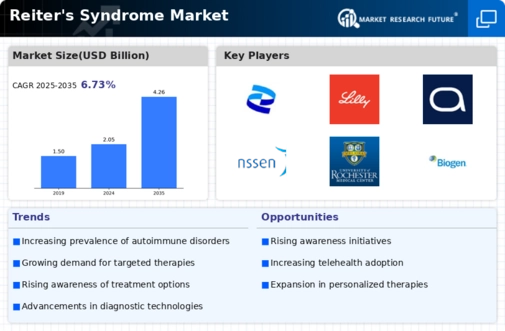Impact of Health Policy Reforms
Health policy reforms are exerting a considerable influence on the Reiter's Syndrome Market. Changes in healthcare regulations and reimbursement policies are shaping the accessibility and affordability of treatment options for patients. Governments are increasingly focusing on improving healthcare delivery systems, which may enhance patient access to necessary therapies. Additionally, policy initiatives aimed at promoting preventive care and early intervention are likely to contribute to better management of Reiter's Syndrome. As healthcare systems adapt to these reforms, the market may witness shifts in demand for various treatment modalities. Therefore, the impact of health policy reforms is expected to play a crucial role in determining the trajectory of the Reiter's Syndrome Market.
Innovations in Diagnostic Techniques
Advancements in diagnostic methodologies are transforming the landscape of the Reiter's Syndrome Market. Enhanced imaging techniques and biomarker identification have improved the accuracy and speed of diagnosis, allowing for timely intervention. The introduction of novel diagnostic tools, such as advanced serological tests, has facilitated the identification of Reiter's Syndrome at earlier stages. This shift not only aids in better patient outcomes but also drives the demand for targeted therapies. As healthcare providers become more adept at recognizing the symptoms and underlying causes of Reiter's Syndrome, the market is likely to witness an uptick in treatment initiation. Consequently, innovations in diagnostic techniques are poised to play a crucial role in shaping the future of the Reiter's Syndrome Market.
Rising Demand for Personalized Medicine
The shift towards personalized medicine is becoming a significant driver in the Reiter's Syndrome Market. Patients are increasingly seeking tailored treatment approaches that consider their unique genetic and environmental factors. This trend is prompting healthcare providers to adopt more individualized treatment plans, which may include targeted therapies and lifestyle modifications. The growing emphasis on personalized medicine is likely to enhance patient adherence to treatment regimens, leading to improved outcomes. Additionally, pharmaceutical companies are responding to this demand by developing drugs that cater to specific patient profiles. As personalized medicine continues to gain traction, it is expected to reshape the treatment landscape within the Reiter's Syndrome Market.
Increasing Prevalence of Reiter's Syndrome
The rising incidence of Reiter's Syndrome appears to be a pivotal driver in the Reiter's Syndrome Market. Recent epidemiological studies indicate that the prevalence of this condition is on the rise, particularly among young adults and males. This increase may be attributed to various factors, including lifestyle changes and environmental triggers. As more individuals are diagnosed, the demand for effective treatment options and management strategies intensifies. Consequently, pharmaceutical companies are likely to invest in research and development to address this growing patient population. The heightened awareness surrounding the disease also contributes to earlier diagnosis, further propelling market growth. Thus, the increasing prevalence of Reiter's Syndrome is expected to significantly influence the dynamics of the Reiter's Syndrome Market.
Growing Investment in Research and Development
The Reiter's Syndrome Market is experiencing a surge in investment directed towards research and development initiatives. Pharmaceutical companies are increasingly allocating resources to explore novel therapeutic agents and treatment modalities. This trend is driven by the need for more effective and personalized treatment options for patients suffering from Reiter's Syndrome. Clinical trials are being conducted to evaluate the efficacy of new drugs, which may lead to breakthroughs in management strategies. Furthermore, collaborations between academic institutions and industry players are fostering innovation in this field. As a result, the influx of funding into research and development is likely to enhance the therapeutic landscape, ultimately benefiting patients and driving growth within the Reiter's Syndrome Market.


















Leave a Comment